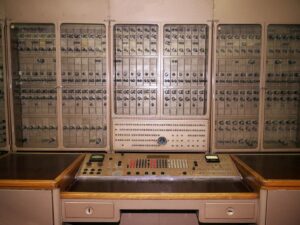Back to: Computer Studies JSS1
Welcome to class!
In today’s class, we shall be talking about the first generation of computers. Please enjoy the class!
First Generation of Computers

The first generation of computers, also known as vacuum tube computers, were characterized by the use of vacuum tubes as the primary electronic components. These computers were large, expensive, and power-hungry, but they were also groundbreaking devices that laid the foundation for modern computing. First generation of computers had a number of formidable features that allowed it to be so powerful in its time. Let’s discuss them below.
Key Characteristics of First Generation Computers
Vacuum tubes: Vacuum tubes were used for logic circuitry, memory, and input/output devices. They were bulky, fragile, and prone to overheating, but they were the only technology available at the time that could perform the complex calculations required for computing.
Machine language: First generation computers were programmed using machine language, which is a low-level programming language that is difficult to learn and use. Machine language programs consist of binary code, which is a series of 0s and 1s that represent instructions for the computer to execute.
Slow speed: First generation computers were very slow by today’s standards. The ENIAC, for example, could only perform about 5,000 additions per second, while modern computers can perform billions of calculations per second.
Limited memory: First generation computers had limited memory, which restricted the amount of data that they could store. The ENIAC, for example, had only 200 bytes of memory, while modern computers have gigabytes or even terabytes of memory.
High cost: First generation computers were very expensive, costing millions of dollars in today’s dollars. This made them out of reach for most businesses and individuals.
Examples of First Generation Computers
Now, let’s talk about some examples of first generation computers.
ENIAC (Electronic Numerical Integrator and Computer): The ENIAC was the first general-purpose electronic computer. It was developed by J. Presper Eckert and John Mauchly at the University of Pennsylvania and was completed in 1945. The ENIAC weighed 30 tons and occupied 1,800 square feet of floor space.
UNIVAC I (Universal Automatic Computer I): The UNIVAC I was developed by the Remington Rand Corporation and was completed in 1951. It was the first commercial computer to be sold in the United States. The UNIVAC I was used by the United States Census Bureau to conduct the 1950 census.
IBM 650: The IBM 650 was developed by IBM and was released in 1954. It was one of the first mass-produced computers and was used by businesses for a variety of applications, including scientific computing, business accounting, and inventory control.
Despite their limitations, first generation computers had a significant impact on the world. They were used for a variety of applications, including scientific research, business data processing, and military applications. First generation computers also helped to lay the foundation for the development of modern computing.
The development of transistors in the late 1940s led to the development of second generation computers, which were smaller, faster, and more reliable than first generation computers. Transistors replaced vacuum tubes as the primary electronic components in computers, and this led to a dramatic increase in computing power. Second generation computers also used assembly language, which is a higher-level programming language than machine language, and this made them easier to program.
The first generation of computers were groundbreaking devices that laid the foundation for modern computing. They were large, expensive, and power-hungry, but they were also powerful and versatile machines that were used for a variety of applications. The development of transistors led to the development of second generation computers, which were smaller, faster, and more reliable than first generation computers.
We have come to the end of today’s class. I hope you enjoyed the class!
In the next class, we shall be discussing Second Generation of Computers.
In case you require further assistance or have any questions, feel free to ask in the comment section below, and trust us to respond as soon as possible. Cheers!
Question Time:
- What were the key characteristics of first generation computers?
- What were the advantages and disadvantages of first generation computers?
- What were some of the most notable examples of first generation computers?
- What impact did first generation computers have on the world?
- How did the development of transistors lead to the transition from first generation computers to second generation computers?
